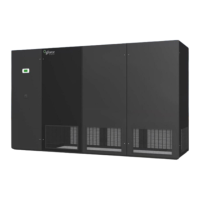55
If the unit is a dual circuit system, temporarily disable the circuit 2 compressor by removing
the fuses to prevent this compressor from starting during charging of circuit 1 compressor.
If the unit is equipped with an optional disconnect switch, turn the disconnect switch to the
ON position to allow facility electrical power to the unit.
The unit dap4 (or Mini-dap4) controller may be turned ON (or OFF) by pressing the Power icon
at the bottom left corner of the main screen. The icon is green when the unit is ON and red
when unit is OFF. Once controller is turned ON there will be a 5 to 600 second start delay
indicated by “Time before start: XXs” on the display to allow the controller to complete a boot
up process and conduct an internal self-test.
Before starting the system, the initial pre-charge process must be complete and make sure
pressure gauges and suction line temperature sensor are hooked up.
Use the Temp Setpoint under Menu B – Setpoints to force the circuit 1 compressor to start in
the normal operating mode. A call for cooling can artificially be created from the controller by
setting the Temp Setpoint to a value lower than the current ambient temperature in the space.
Example: Existing return air temperature (RAT) is 75F (23.9C), set the controller
Temperature Setpoint to 65F (18.3C). The compressor will start and run at a full speed.
If the unit is in OFFbyKEY position, hold the ESC key for 5 seconds to start the system via the
controller. Allow time for all fans to start and for the system to stabilize to room temperature.
Bubbles in the sight glass are not unusual at this point. It is likely that more refrigerant will be
required to complete the charging procedure.
Finish charging circuit 1 by slowly opening the valve on the refrigerant manifold set to meter
liquid refrigerant into the low side of the system. Use a liquid charging adapter to prevent
liquid refrigerant from entering the compressor.
NOTICE: Charging to a full liquid line sight glass should never be the sole
means of determining the correct refrigerant charge. Other parameters such
as superheat, suction pressure, head pressure, sub-cooling and ambient
temperature are also important factors. A system charged to a clear sight
glass is often overcharged.

